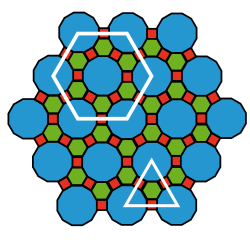
In geometry, a tiling is a partition of the plane (or any other geometric setting) into closed sets (called tiles), without gaps or overlaps (other than the boundaries of the tiles). A tiling is considered periodic if there exist translations in two independent directions which map the tiling onto itself. Such a tiling is composed of a single fundamental unit or primitive cell which repeats endlessly and regularly in two independent directions. An example of such a tiling is shown in the adjacent diagram (see the image description for more information). A tiling that cannot be constructed from a single primitive cell is called nonperiodic. If a given set of tiles allows only nonperiodic tilings, then this set of tiles is called aperiodic. The tilings obtained from an aperiodic set of tiles are often called aperiodic tilings, though strictly speaking it is the tiles themselves that are aperiodic. (The tiling itself is said to be "nonperiodic".)
The first table explains the abbreviations used in the second table. The second table contains all known aperiodic sets of tiles and gives some additional basic information about each set. This list of tiles is still incomplete.
Explanations
| Abbreviation | Meaning | Explanation |
|---|---|---|
| E | Euclidean plane | normal flat plane |
| H | hyperbolic plane | plane, where the parallel postulate does not hold |
| E | Euclidean 3 space | space defined by three perpendicular coordinate axes |
| MLD | Mutually locally derivable | two tilings are said to be mutually locally derivable from each other, if one tiling can be obtained from the other by a simple local rule (such as deleting or inserting an edge) |
List
This is a dynamic list and may never be able to satisfy particular standards for completeness. You can help by adding missing items with reliable sources.| Image | Name | Number of tiles | Space | Publication Date | Refs. | Comments |
|---|---|---|---|---|---|---|
 |
Trilobite and cross tiles | 2 | E | 1999 | Tilings MLD from the chair tilings. | |
 |
Penrose P1 tiles | 6 | E | 1974 | Tilings MLD from the tilings by P2 and P3, Robinson triangles, and "Starfish, ivy leaf, hex". | |
 |
Penrose P2 tiles | 2 | E | 1977 | Tilings MLD from the tilings by P1 and P3, Robinson triangles, and "Starfish, ivy leaf, hex". | |
 |
Penrose P3 tiles | 2 | E | 1978 | Tilings MLD from the tilings by P1 and P2, Robinson triangles, and "Starfish, ivy leaf, hex". | |
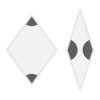 |
Binary tiles | 2 | E | 1988 | Although similar in shape to the P3 tiles, the tilings are not MLD from each other. Developed in an attempt to model the atomic arrangement in binary alloys. | |
 |
Robinson tiles | 6 | E | 1971 | Tiles enforce aperiodicity by forming an infinite hierarchy of square lattices. | |
 |
Ammann A1 tiles | 6 | E | 1977 | Tiles enforce aperiodicity by forming an infinite hierarchal binary tree. | |
 |
Ammann A2 tiles | 2 | E | 1986 | ||
 |
Ammann A3 tiles | 3 | E | 1986 | ||
 |
Ammann A4 tiles | 2 | E | 1986 | Tilings MLD with Ammann A5. | |
 |
Ammann A5 tiles | 2 | E | 1982 | Tilings MLD with Ammann A4. | |
| No image | Penrose hexagon-triangle tiles | 3 | E | 1997 | Uses mirror images of tiles for tiling. | |
| No image | Pegasus tiles | 2 | E | 2016 | Variant of the Penrose hexagon-triangle tiles. Discovered in 2003 or earlier. | |
 |
Golden triangle tiles | 10 | E | 2001 | Date is for discovery of matching rules. Dual to Ammann A2. | |
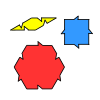 |
Socolar tiles | 3 | E | 1989 | Tilings MLD from the tilings by the Shield tiles. | |
 |
Shield tiles | 4 | E | 1988 | Tilings MLD from the tilings by the Socolar tiles. | |
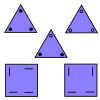 |
Square triangle tiles | 5 | E | 1986 | ||
 |
Starfish, ivy leaf and hex tiles | 3 | E | Tiling is MLD to Penrose P1, P2, P3, and Robinson triangles. | ||
 |
Robinson triangle | 4 | E | Tiling is MLD to Penrose P1, P2, P3, and "Starfish, ivy leaf, hex". | ||
 |
Danzer triangles | 6 | E | 1996 | ||
 |
Pinwheel tiles | E | 1994 | Date is for publication of matching rules. | ||
 |
Socolar–Taylor tile | 1 | E | 2010 | Not a connected set. Aperiodic hierarchical tiling. | |
| No image | Wang tiles | 20426 | E | 1966 | ||
| No image | Wang tiles | 104 | E | 2008 | ||
| No image | Wang tiles | 52 | E | 1971 | Tiles enforce aperiodicity by forming an infinite hierarchy of square lattices. | |
 |
Wang tiles | 32 | E | 1986 | Locally derivable from the Penrose tiles. | |
| No image | Wang tiles | 24 | E | 1986 | Locally derivable from the A2 tiling. | |
 |
Wang tiles | 16 | E | 1986 | Derived from tiling A2 and its Ammann bars. | |
 |
Wang tiles | 14 | E | 1996 | ||
 |
Wang tiles | 13 | E | 1996 | ||
 |
Wang tiles | 11 | E | 2015 | Smallest aperiodic set of Wang tiles. | |
| No image | Decagonal Sponge tile | 1 | E | 2002 | Porous tile consisting of non-overlapping point sets. | |
| No image | Goodman-Strauss strongly aperiodic tiles | 85 | H | 2005 | ||
| No image | Goodman-Strauss strongly aperiodic tiles | 26 | H | 2005 | ||
 |
Böröczky hyperbolic tile | 1 | H | 1974 | Only weakly aperiodic. | |
| No image | Schmitt tile | 1 | E | 1988 | Screw-periodic. | |
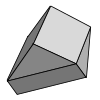 |
Schmitt–Conway–Danzer tile | 1 | E | Screw-periodic and convex. | ||
 |
Socolar–Taylor tile | 1 | E | 2010 | Periodic in third dimension. | |
| No image | Penrose rhombohedra | 2 | E | 1981 | ||
 |
Mackay–Amman rhombohedra | 4 | E | 1981 | Icosahedral symmetry. These are decorated Penrose rhombohedra with a matching rule that force aperiodicity. | |
| No image | Wang cubes | 21 | E | 1996 | ||
| No image | Wang cubes | 18 | E | 1999 | ||
| No image | Danzer tetrahedra | 4 | E | 1989 | ||
 |
I and L tiles | 2 | E for all n ≥ 3 | 1999 | ||
 |
Smith–Myers–Kaplan–Goodman-Strauss or "Hat" polytile | 1 | E | 2023 | Mirrored monotiles, the first example of an "einstein". | |
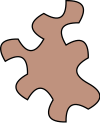 |
Smith–Myers–Kaplan–Goodman-Strauss or "Spectre" polytile | 1 | E | 2023 | "Strictly chiral" aperiodic monotile, the first example of a real "einstein". | |
 |
TS1 | 2 | E | 2014 |
References
- Grünbaum, Branko; Shephard, Geoffrey C. (1977), "Tilings by Regular Polygons", Math. Mag., 50 (5): 227–247, doi:10.2307/2689529, JSTOR 2689529
- Edwards, Steve, "Fundamental Regions and Primitive cells", Tiling Plane & Fancy, Kennesaw State University, archived from the original on 2010-07-05, retrieved 2017-01-11
- Wagon, Steve (2010), Mathematica in Action (3rd ed.), Springer Science & Business Media, p. 268, ISBN 9780387754772
- Goodman-Strauss, Chaim (1999), "A Small Aperiodic Set of Planar Tiles", European J. Combin., 20 (5): 375–384, doi:10.1006/eujc.1998.0281 (preprint available)
- Penrose, Roger (1974), "The role of Aesthetics in Pure and Applied Mathematical Research", Bulletin of the Institute of Mathematics and Its Applications, 10 (2): 266–271
- Mikhael, Jules (2010), Colloidal Monolayers On Quasiperiodic Laser Fields (PDF) (Dr. rer. nat thesis), p. 23, doi:10.18419/opus-4924, archived (PDF) from the original on 2011-07-17
- Gardner, Martin (January 1977), "Mathematical Games: Extraordinary nonperiodic tiling that enriches the theory of tiles", Scientific American, 236 (1): 110–121, Bibcode:1977SciAm.236a.110G, doi:10.1038/scientificamerican0177-110
- Gardner, Martin (1997), Penrose Tiles to Trapdoor Ciphers (Revised ed.), The Mathematical Association of America, p. 86, ISBN 9780883855218
- Penrose, Roger (1978), "Pentaplexity" (PDF), Eureka, 39: 16–22
- Penrose, Roger (1979), "Pentaplexity", Math. Intell., 2 (1): 32–37, doi:10.1007/bf03024384, S2CID 120305260, archived from the original on 2011-06-07, retrieved 2010-07-26
- Lançon, F.; Billard, L. (1988), "Two-dimensional system with a quasi-crystalline ground state" (PDF), Journal de Physique, 49 (2): 249–256, CiteSeerX 10.1.1.700.3611, doi:10.1051/jphys:01988004902024900, archived (PDF) from the original on 2011-05-09
- Godrèche, C.; Lançon, F. (1992), "A simple example of a non-Pisot tiling with five-fold symmetry" (PDF), Journal de Physique I, 2 (2): 207–220, Bibcode:1992JPhy1...2..207G, doi:10.1051/jp1:1992134, S2CID 120168483, archived (PDF) from the original on 2012-03-07
- ^ Robinson, Raphael M. (1971), "Undecidability and nonperiodicity of tilings in the plane", Inventiones Mathematicae, 12 (3): 177–209, Bibcode:1971InMat..12..177R, doi:10.1007/BF01418780, S2CID 14259496
- Goodman-Strauss, Chaim (1999), Sadoc, J. F.; Rivier, N. (eds.), "Aperiodic Hierarchical tilings", NATO ASI Series, Series E: Applied Sciences, 354 (Foams and Emulsions): 481–496, doi:10.1007/978-94-015-9157-7_28, ISBN 978-90-481-5180-6
- Gardner, Martin (2001), The Colossal Book of Mathematics, W. W. Norton & Company, p. 76, ISBN 978-0393020236
- Grünbaum, Branko & Shephard, Geoffrey C. (1986), Tilings and Patterns, New York: W. H. Freeman, ISBN 978-0-7167-1194-0, according to Dutch, Steven (2003), Aperiodic Tilings, University of Wisconsin - Green Bay, archived from the original on 2006-08-30, retrieved 2011-04-02; cf. Savard, John J. G., Aperiodic Tilings Within Conventional Lattices
- ^ Grünbaum, Branko & Shephard, Geoffrey C. (1986), Tilings and Patterns, New York: W. H. Freeman, ISBN 978-0-7167-1194-0
- ^ Ammann, Robert; Grünbaum, Branko; Shephard, Geoffrey C. (July 1992), "Aperiodic tiles", Discrete & Computational Geometry, 8 (1): 1–25, doi:10.1007/BF02293033, S2CID 39158680
- Harriss, Edmund; Frettlöh, Dirk, "Ammann A4", Tilings Encyclopedia, Bielefeld University
- Beenker, F. P. M. (1982), Algebraic theory of non-periodic tilings of the plane by two simple building blocks: a square and a rhombus, TH Report, vol. 82-WSK04, Eindhoven University of Technology
- Komatsu, Kazushi; Nomakuchi, Kentaro; Sakamoto, Kuniko; Tokitou, Takashi (2004), "Representation of Ammann-Beenker tilings by an automaton", Nihonkai Math. J., 15 (2): 109–118, archived from the original on 2012-09-22, retrieved 2017-01-12
- Harriss, Edmund; Frettlöh, Dirk, "Ammann-Beenker", Tilings Encyclopedia, Bielefeld University
- ^ Penrose, R. (1997), "Remarks on tiling: Details of a (1+ε+ε) aperiodic set.", NATO ASI Series, Series C: Mathematical and Physical Sciences, 489 (The Mathematics of Long-Range Aperiodic Order): 467–497, doi:10.1007/978-94-015-8784-6_18, ISBN 978-0-7923-4506-0
- Baake, Michael; Gähler, Franz; Grimm, Uwe (2012). "Hexagonal inflation tilings and planar monotiles". arXiv:1210.3967 .
- ^ Goodman-Strauss, Chaim (2016). "The Pegasus Tiles: an aperiodic pair of tiles". arXiv:1608.07166 .
- Goodman-Strauss, Chaim (2003), An aperiodic pair of tiles (PDF), University of Arkansas
- Danzer, Ludwig; van Ophuysen, Gerrit (2001), "A species of planar triangular tilings with inflation factor ", Res. Bull. Panjab Univ. Sci., 50 (1–4): 137–175, MR 1914493
- Gelbrich, G (1997), "Fractal Penrose tiles II. Tiles with fractal boundary as duals of Penrose triangles", Aequationes Mathematicae, 54 (1–2): 108–116, doi:10.1007/bf02755450, MR 1466298, S2CID 120531480
- Socolar, Joshua E. S. (1989), "Simple octagonal and dodecagonal quasicrystals", Physical Review B, 39 (15): 10519–51, Bibcode:1989PhRvB..3910519S, doi:10.1103/PhysRevB.39.10519, PMID 9947860
- Gähler, Franz; Lück, Reinhard; Ben-Abraham, Shelomo I.; Gummelt, Petra (2001), "Dodecagonal tilings as maximal cluster coverings", Ferroelectrics, 250 (1): 335–338, Bibcode:2001Fer...250..335G, doi:10.1080/00150190108225095, S2CID 123171399
- Savard, John J. G., The Socolar tiling
- Gähler, Franz (1988), "Crystallography of dodecagonal quasicrystals"" (PDF), in Janot, Christian (ed.), Quasicrystalline materials: Proceedings of the I.L.L. / Codest Workshop, Grenoble, 21–25 March 1988, Singapore: World Scientific, pp. 272–284
- Gähler, Franz; Frettlöh, Dirk, "Shield", Tilings Encyclopedia, Bielefeld University
- Gähler, Franz (1993), "Matching rules for quasicrystals: the composition-decomposition method" (PDF), Journal of Non-Crystalline Solids, 153–154 (Proceddings of the Fourth International Conference on Quasicrystals): 160–164, Bibcode:1993JNCS..153..160G, CiteSeerX 10.1.1.69.2823, doi:10.1016/0022-3093(93)90335-u, archived (PDF) from the original on 2011-07-17
- Stampfli, P. (1986), "A Dodecagonal Quasiperiodic Lattice in Two Dimensions", Helv. Phys. Acta, 59: 1260–1263
- Hermisson, Joachim; Richard, Christoph; Baake, Michael (1997), "A Guide to the Symmetry Structure of Quasiperiodic Tiling Classes", Journal de Physique I, 7 (8): 1003–1018, Bibcode:1997JPhy1...7.1003H, CiteSeerX 10.1.1.46.5796, doi:10.1051/jp1:1997200
- ^ Lord, Eric. A. (1991), "Quasicrystals and Penrose patterns" (PDF), Current Science, 61 (5): 313–319, archived (PDF) from the original on October 24, 2016
- Olamy, Z.; Kléman, M. (1989), "A two dimensional aperiodic dense tiling" (PDF), Journal de Physique, 50 (1): 19–33, doi:10.1051/jphys:0198900500101900, archived (PDF) from the original on 2011-05-09
- Mihalkovič, M.; Henley, C. L.; Widom, M. (2004), "Combined energy-diffraction data refinement of decagonal AlNiCo", Journal of Non-Crystalline Solids, 334–335 (8th International Conference on Quasicrystals): 177–183, arXiv:cond-mat/0311613, Bibcode:2004JNCS..334..177M, doi:10.1016/j.jnoncrysol.2003.11.034, S2CID 18958430
- Nischke, K.-P.; Danzer, L. (1996), "A construction of inflation rules based on n-fold symmetry", Discrete & Computational Geometry, 15 (2): 221–236, doi:10.1007/bf02717732, S2CID 22538367
- Hayashi, Hiroko; Kawachi, Yuu; Komatsu, Kazushi; Konda, Aya; Kurozoe, Miho; Nakano, Fumihiko; Odawara, Naomi; Onda, Rika; Sugio, Akinobu; Yamauchi, Masatetsu (2009), "Abstract: Notes on vertex atlas of planar Danzer tiling" (PDF), Japan Conference on Computational Geometry and Graphs, Kanazawa, November 11–13, 2009
- Radin, Charles (1994), "The pinwheel tilings of the plane", Annals of Mathematics, Second Series, 139 (3): 661–702, CiteSeerX 10.1.1.44.9723, doi:10.2307/2118575, JSTOR 2118575, MR 1283873
- Radin, Charles (1993), "Symmetry of Tilings of the Plane", Bull. Amer. Math. Soc., 29 (2): 213–217, arXiv:math/9310234, Bibcode:1993math.....10234R, CiteSeerX 10.1.1.45.5319, doi:10.1090/s0273-0979-1993-00425-7, S2CID 14935227
- Radin, Charles; Wolff, Mayhew (1992), "Space tilings and local isomorphism", Geom. Dedicata, 42 (3): 355–360, doi:10.1007/bf02414073, MR 1164542, S2CID 16334831
- Radin, C (1997), "Aperiodic tilings, ergodic theory, and rotations", NATO ASI Series, Series C: Mathematical and Physical Sciences, 489 (The mathematics of long-range aperiodic order), Kluwer Acad. Publ., Dordrecht, MR 1460035
- ^ Socolar, Joshua E. S.; Taylor, Joan M. (2011), "An aperiodic hexagonal tile", Journal of Combinatorial Theory, Series A, 118 (8): 2207–2231, arXiv:1003.4279v1, doi:10.1016/j.jcta.2011.05.001, S2CID 27912253
- ^ Socolar, Joshua E. S.; Taylor, Joan M. (2011), "Forcing nonperiodicity with a single tile", The Mathematical Intelligencer, 34 (1): 18–28, arXiv:1009.1419v1, doi:10.1007/s00283-011-9255-y, S2CID 10747746
- Berger, Robert (1966), "The Undecidability of the Domino Problem", Memoirs of the American Mathematical Society, 66 (66), doi:10.1090/memo/0066, ISBN 978-0-8218-1266-2
- Ollinger, Nicolas (2008), "Two-by-two Substitution Systems and the Undecidability of the Domino Problem" (PDF), Logic and Theory of Algorithms, Lecture Notes in Computer Science, vol. 5028, Springer, pp. 476–485, CiteSeerX 10.1.1.371.9357, doi:10.1007/978-3-540-69407-6_51, ISBN 978-3-540-69405-2
- Kari, J.; Papasoglu, P. (1999), "Deterministic Aperiodic Tile Sets", Geometric and Functional Analysis, 9 (2): 353–369, doi:10.1007/s000390050090, S2CID 8775966
- ^ Lagae, Ares; Kari, Jarkko; Dutré, Phillip (2006), Aperiodic Sets of Square Tiles with Colored Corners, Report CW, vol. 460, KU Leuven, p. 15, CiteSeerX 10.1.1.89.1294
- Carbone, Alessandra; Gromov, Mikhael; Prusinkiewicz, Przemyslaw (2000), Pattern Formation in Biology, Vision and Dynamics, Singapore: World Scientific, ISBN 978-981-02-3792-9
- Kari, Jarkko (1996), "A small aperiodic set of Wang tiles", Discrete Mathematics, 160 (1–3): 259–264, doi:10.1016/0012-365X(95)00120-L
- Lagae, Ares (2007), Tile Based Methods in Computer Graphics (PDF) (PhD thesis), KU Leuven, p. 149, ISBN 978-90-5682-789-2, archived from the original (PDF) on 2011-07-20
- Culik, Karel; Kari, Jarkko (1997), "On aperiodic sets of Wang tiles", Foundations of Computer Science, Lecture Notes in Computer Science, vol. 1337, pp. 153–162, doi:10.1007/BFb0052084, ISBN 978-3-540-63746-2
- Culik, Karel (1996), "An aperiodic set of 13 Wang tiles", Discrete Mathematics, 160 (1–3): 245–251, CiteSeerX 10.1.1.53.5421, doi:10.1016/S0012-365X(96)00118-5
- Jeandel, Emmanuel; Rao, Michaël (2021), "An aperiodic set of 11 Wang tiles", Advances in Combinatorics: Paper No. 1, 37, arXiv:1506.06492, doi:10.19086/aic.18614, MR 4210631, S2CID 13261182
- Zhu, Feng (2002), The Search for a Universal Tile (PDF) (BA thesis), Williams College
- Bailey, Duane A.; Zhu, Feng (2001), A Sponge-Like (Almost) Universal Tile (PDF), CiteSeerX 10.1.1.103.3739
- Goodman-Strauss, Chaim (2010), "A hierarchical strongly aperiodic set of tiles in the hyperbolic plane" (PDF), Theoretical Computer Science, 411 (7–9): 1085–1093, doi:10.1016/j.tcs.2009.11.018
- ^ Goodman-Strauss, Chaim (2005), "A strongly aperiodic set of tiles in the hyperbolic plane", Invent. Math., 159 (1): 130–132, Bibcode:2004InMat.159..119G, CiteSeerX 10.1.1.477.1974, doi:10.1007/s00222-004-0384-1, S2CID 5348203
- Böröczky, K. (1974), "Gömbkitöltések állandó görbületü terekben I", Matematikai Lapok, 25: 265–306
- Böröczky, K. (1974), "Gömbkitöltések állandó görbületü terekben II", Matematikai Lapok, 26: 67–90
- Dolbilin, Nikkolai; Frettlöh, Dirk (2010), "Properties of Böröczky tilings in high dimensional hyperbolic spaces" (PDF), European J. Combin., 31 (4): 1181–1195, arXiv:0705.0291, CiteSeerX 10.1.1.246.9821, doi:10.1016/j.ejc.2009.11.016, S2CID 13607905
- ^ Radin, Charles (1995), "Aperiodic tilings in higher dimensions" (PDF), Proceedings of the American Mathematical Society, 123 (11), American Mathematical Society: 3543–3548, doi:10.2307/2161105, JSTOR 2161105, retrieved 2013-09-25
- Mackay, Alan L. (1981), "De Nive Quinquangula: On the pentagonal snowflake" (PDF), Sov. Phys. Crystallogr., 26 (5): 517–522, archived (PDF) from the original on 2011-07-21
- Meisterernst, Götz, Experimente zur Wachstumskinetik Dekagonaler Quasikristalle (PDF) (Dissertation), Ludwig Maximilian University of Munich, pp. 18–19, archived (PDF) from the original on 2011-06-17
- Jirong, Sun (1993), "Structure Transition of the Three-Dimensional Penrose Tiling Under Phason Strain Field", Chinese Physics Letters, 10 (8): 449–452, Bibcode:1993ChPhL..10..449S, doi:10.1088/0256-307x/10/8/001, S2CID 250911962
- Inchbald, Guy (2002), A 3-D Quasicrystal Structure
- Lord, E. A.; Ranganathan, S.; Kulkarni, U. D. (2001), "Quasicrystals: tiling versus clustering" (PDF), Philosophical Magazine A, 81 (11): 2645–2651, Bibcode:2001PMagA..81.2645L, CiteSeerX 10.1.1.487.2640, doi:10.1080/01418610108216660, S2CID 138403519, archived (PDF) from the original on 2011-07-21
- Rudhart, Christoph Paul (June 1999), Zur numerischen Simulation des Bruchs von Quasikristallen (Thesis), University of Stuttgart, p. 11, doi:10.18419/opus-4639
- Lord, E. A.; Ranganathan, S.; Kulkarni, U. D. (2000), "Tilings, coverings, clusters and quasicrystals" (PDF), Current Science, 78 (1): 64–72, archived (PDF) from the original on 2011-07-21
- Katz, A. (1988), "Theory of Matching Rules for the 3-Dimensional Penrose Tilings", Communications in Mathematical Physics, 118 (2): 263–288, Bibcode:1988CMaPh.118..263K, doi:10.1007/BF01218580, S2CID 121086829
- Culik, Karel; Kari, Jarkko (1995), "An aperiodic set of Wang cubes", Journal of Universal Computer Science, 1 (10), CiteSeerX 10.1.1.54.5897, doi:10.3217/jucs-001-10-0675
- Walther. Gerd; Selter, Christoph, eds. (1999), Mathematikdidaktik als design science : Festschrift für Erich Christian Wittmann, Leipzig: Ernst Klett Grundschulverlag, ISBN 978-3-12-200060-8
- Danzer, L. (1989), "Three-Dimensional Analogs of the Planar Penrose Tilings and Quasicrystals", Discrete Mathematics, 76 (1): 1–7, doi:10.1016/0012-365X(89)90282-3
- Zerhusen, Aaron (1997), Danzer's three dimensional tiling, University of Kentucky
- Goodman-Strauss, Chaim (1999), "An Aperiodic Pair of Tiles in E for all n ≥ 3", European J. Combin., 20 (5): 385–395, doi:10.1006/eujc.1998.0282 (preprint available)
- Smith, David; Myers, Joseph Samuel; Kaplan, Craig S.; Goodman-Strauss, Chaim (2023). "An aperiodic monotile". arXiv:2303.10798 .
- Smith, David; Myers, Joseph Samuel; Kaplan, Craig S.; Goodman-Strauss, Chaim (2023). "A chiral aperiodic monotile". arXiv:2305.17743 .
- Mehta, Chirag (2021-04-03). "The art of what if". Journal of Mathematics and the Arts. 15 (2): 198–200. doi:10.1080/17513472.2021.1919977. ISSN 1751-3472.
External links
- Stephens P. W., Goldman A. I. The Structure of Quasicrystals
- Levine D., Steinhardt P. J. Quasicrystals I Definition and structure
- Tilings Encyclopedia
| Tessellation | |||||||||||||
|---|---|---|---|---|---|---|---|---|---|---|---|---|---|
|   | ||||||||||||
| |||||||||||||
| |||||||||||||
| |||||||||||||
 ", Res. Bull. Panjab Univ. Sci., 50 (1–4): 137–175,
", Res. Bull. Panjab Univ. Sci., 50 (1–4): 137–175,